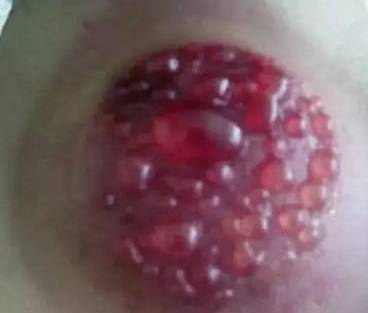
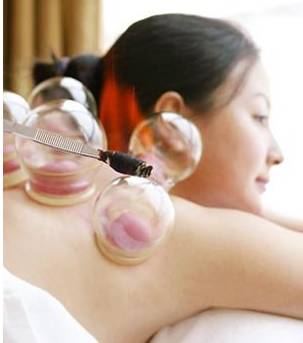
Generally, after cupping, if the area covered by the cup shows deep red, purple-black, or blue spots, and is slightly painful to the touch, it is often due to stagnation of blood and heat toxins (yūxuè rèdú); if there is swelling, small blisters, and a lot of moisture inside the cup, it is often due to dampness and water retention (shīzhì shuǐyǐn); if the skin color shows no significant change and feels cool, it is often a sign of deficiency and cold conditions (xūhán). However, one should not generalize; each situation must be analyzed specifically.
The formation of blisters is due to the inability of internal dampness to be expelled in time, accumulating on the skin surface, which is why it comes out through the pores during cupping.
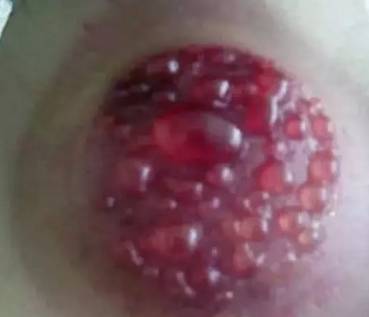
Note that the skin should be dry for a few days to heal.
If the blisters are large, they should be punctured, as large blisters are likely to be pressed or broken in daily life. It is better to puncture them first and apply some purple medicine or similar to both reduce inflammation and contract the wound, thus preventing infection.
From a treatment perspective, the emergence of blisters can actually be beneficial, as the cupping area is often on acupuncture points or meridians. During the absorption of the blisters, the exuded tissue fluid also provides enhanced stimulation to the acupuncture points or meridians, thus improving the treatment effect. Ancient practitioners even believed that the skin breaking and purulent formation at a certain acupuncture point enhances stimulation, which is much more effective than simply removing the blisters.
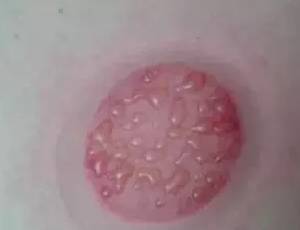
Different blisters can represent different bodily conditions!
Let’s learn which blisters correspond to which health issues:
Purple-black——Insufficient blood supply, accumulation of cold.
Purple with black spots——Poor circulation of qi and blood
Purple spots with varying block shapes——Wind-dampness
Bright red and hot in the area——Yang syndrome, heat syndrome, excess syndrome, intense heat toxins, body constitution with yin deficiency, and excess fire
Red and dark——Thick blood, high blood lipids, insufficient blood supply
Bruises or blood blisters that are gray-white or pale——Deficiency cold, dampness
Skin slightly itchy——Wind evil, damp syndrome
Blisters, swelling, dampness——Cold syndrome, excessive dampness
Water droplets inside the cup——Heavy cold and dampness
Purple-red, dark red——Yin syndrome, cold syndrome, blood stasis
Flushed, light red——Deficiency syndrome
Local area quickly returns to normal——Indicates quick recovery
Cupping should also be tailored to individual constitution.
Traditional Chinese Medicine (TCM) believes that excessive dampness in the body is a common ailment of modern people. The term “heavy dampness” can be categorized into two main types: external dampness and internal dampness, depending on the location of the disease and symptom presentation. External dampness is caused by humid summer weather, or by living in damp conditions, getting wet in the rain, wearing wet clothes, or using air conditioning after bathing, which allows external pathogens to invade the body, preventing the evaporation of body fluids, leading to the accumulation of dampness and resulting in illness. This often manifests as wind-damp joint pain, lower back pain, etc.
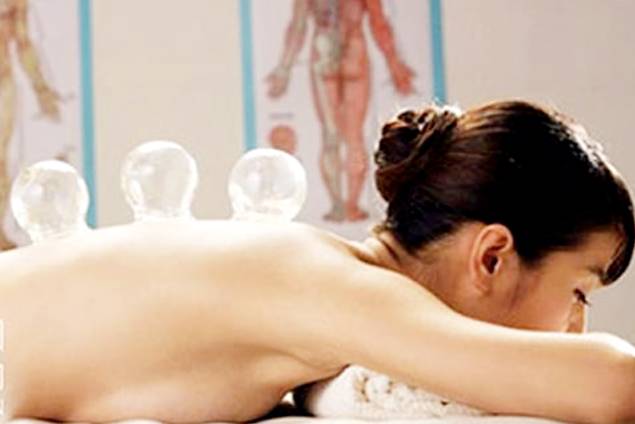
Contraindications for Cupping
1Skin allergies or skin injuries
Cupping may exacerbate allergic symptoms. It is also not advisable to cup over ulcerated areas, as this can lead to infection and blisters, worsening the ulcer. If there are any ruptured areas on the skin, cupping should not be performed on those areas. After cupping, one should not rush to take a shower to avoid skin damage and inflammation. Generally, once a week is a suitable frequency for cupping. During the cupping process, attention should be paid to the “heat”; the duration should not be too long. If blisters or burns occur, one should seek medical attention promptly.
2Pregnant women and women during menstruation
Especially for pregnant women, cupping on the abdomen and lower back is not advisable. Inappropriate cupping during pregnancy can lead to threatened miscarriage. The same reasoning applies during menstruation; cupping on the lower abdomen or lower back can lead to excessive menstrual flow.
3Individuals with weak constitutions
Cupping and gua sha for cooling may be effective and have no side effects, but some individuals should avoid this treatment. Those with heart disease, blood disorders, skin diseases, skin injuries, tuberculosis, osteoporosis, late-stage cancer, various infectious diseases, weak constitutions, and the elderly should use caution. Moreover, it is crucial not to face air conditioning or fans during cupping to prevent invasion by wind pathogens.
4After a full meal
Blood flows to the liver for metabolic work; cupping at this time forces qi and blood to be redirected to the cupping area, causing the heart to beat faster to supply blood, which can lead to dizziness, nausea, and other discomforts.
5Repeated cupping on the same spot
Many patients often cup repeatedly on the same spot after becoming ill, which can damage the skin, causing redness, swelling, and rupture. When cupping, it is advisable to cup in multiple locations to enhance treatment effects. Additionally, do not cup in the same area until the bruising from the previous cupping has disappeared.
6Showering immediately after cupping
Many people like to take a shower right after cupping, thinking it feels good; however, this is incorrect. Showering at this time can easily cause skin rupture and inflammation. Especially with cold showers, as the skin’s pores are open, it can easily lead to a cold. The correct time to shower is 1 to 2 hours after cupping. After cupping, it is important to keep warm, and the shower water temperature should be slightly higher.

